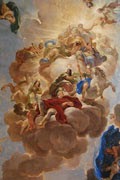 A must-see while on a tuscany vacation is the Leaning Tower of Pisa. This is one of the world's best known landmarks and an international symbol of Italy. I mean come on, there are only a few things you think of when you think of landmarks in Italy; St Peter's Basilica, Venice gondola rides, and the Leaning Tower! But needless to say, it will not disappoint being one of the most remarkable architectural structures of medieval Europe.
A must-see while on a tuscany vacation is the Leaning Tower of Pisa. This is one of the world's best known landmarks and an international symbol of Italy. I mean come on, there are only a few things you think of when you think of landmarks in Italy; St Peter's Basilica, Venice gondola rides, and the Leaning Tower! But needless to say, it will not disappoint being one of the most remarkable architectural structures of medieval Europe.Built as the bell tower for the cathedral on Piazza del Duomo, also known as Miracle's Square, the tower leans approximately 13 feet off base due to the weight of the marble and the weak soil. This completely baffled and amazes crowds for hundreds of years, the tower has experienced many a calamity during its lifetime but remains still standing......well leaning. Its construction began in 1173 and went on for more or less two hundred years. the ground beneath the tower was soft and even before its completion it already began to tilt. Even so much that the builders began to compensate by angling the building. Today, if you look from the right spot you can notice that the tower is not perfectly straight. Regardless of which direction the tower is leaning, it needs to be high on your visit list. Trust me it won't take to long and it will be something that is well worth it!







